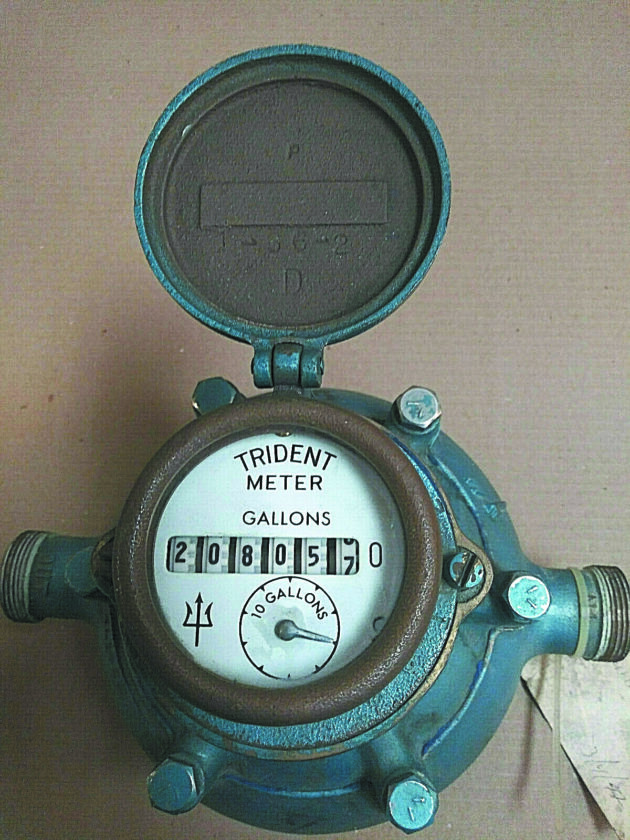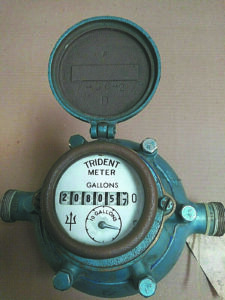Water meters dominate public discussion

A Trident water meter manufactured in the era addressed in this narrative. (Courtesy photo)
ISHPEMING — “At Wednesday’s meeting of the common council it was decided by that body to put in water meters for the purpose of preventing the waste which is now going on. The report of the investigating committee which visited the cities of Milwaukee, Madison and Iron Mountain, was unanimous in favor of the meter, and there as, after listening to it, only one dissenting vote against the introduction of the measuring device. On the vote to raise money with which to put in the improvement there was not a ‘nay’ registered. The report of the committee, which will be found in the proceedings of the common council published in another column, was convincing, and while a few citizens appeared at the council room for the purpose of opposing the proposition, not one voiced his former opinions after listening to the report of the committee. The latter showed a saving of from 40 to 75 per cent in the towns using the meters, and at the same time the water was given to the consumer at low rates, the charge being about 4 1/2 cents for 750 gallons, which is certainly reasonable.” (Iron Ore, Aug. 10, 1901)
“Ishpeming will have a water meter system. The question was definitely decided at Wednesday night’s meeting of the council, when the board of public works was instructed to expend $12,000 ($459,601 today) for meters and in making improvements to the water system. Of this sum only $7,000 is available, and it will be necessary for the city to borrow the balance. A resolution authorizing the mayor and the recorder to negotiate a loan of $5,000 was passed unanimously.
The meeting on Wednesday evening was short, sharp and decisive. From the roll call until the motion to adjourn was passed not a moment was wasted in idle chatter.
The report of the committee appointed to investigate the workings of water meters in cities where they are in use was read, it was a very elaborate document and went into a detailed account of the saving of water in Milwaukee and Madison, Wis., since the adoption of the meter system. In both these cities facts were obtained showing that the saving amounted to between sixty and ninety per cent. In Milwaukee there are 30,000 meters in use and only 4,5000 consumers paying a flat rate for water.
The committee also reported on the system as it exists at Iron Mountain. The water department has no trouble from frozen meters, as a device is in use there, which sufficiently protects them from freezing. The use of the meter in that city demonstrated that it can be utilized in this climate, if proper care be given to protecting it.” (Mining Journal, Aug. 9, 1901)
“At a recent meeting of the board of public works a contract to supply the city with five hundred Trident water meters was awarded to the Neptune Water Meter Company of Chicago.
While the Neptune company did not submit the lowest figure for supplying the meters, yet the contract it presented was far superior to the ones offered by the other concerns. Its guarantee is far more liberal than any of the others. Taking everything into consideration, including the quality of the meters, the board feels it has made no mistake in selecting the Trident meter.
The first consignment will arrive the latter part of next week and will be at once installed in the places where the most water is consumed. This, of course, will be at the mines and the railroad water tanks. The saloons and other large consumers will be supplied with machines as soon as possible. The whole consignment of five hundred meters must be delivered to the city within the next three months so that they can be put in place before the cold weather sets in.” (Mining Journal, Aug. 17, 1901)
“Already the wisdom of introducing the water meters in this city is being shown. At the pumping station one pump can now keep up pressure to the desired point in midday, and the natural pressure on the mains has been increased many pounds. This has been brought about by the fact that people are using more care in the use of water. Many have already protected their pipes to prevent freezing and the practice of letting water run constantly to keep it cool for an occasional drink has been discontinued to a great extent.” (Iron Ore, Sept. 14, 1901)
At the December meeting of the common council, the city set the water rates for the coming year.
“Having examined into the matter of rates for the water consumers of this city, and having gone into the matter as carefully as we could with the data obtainable, we beg to recommend the following annual water rates from January 1st, 1902 for all metered premises. For the first fifty thousand gallons (50,000) ten cents per thousand gallons. For the second fifty thousand gallons, (50,000) eight cents per thousand gallons. For all in excess of one hundred thousand gallons, (100,000) four cents per though gallons. Minimum rate per six months, two dollars ($2).
In arriving at these figures and recommendation, we have taken careful readings of all meters, estimating the yearly consumption of mines, railroads, business houses, and have compared them with the cost of operating the water works system as well as with the rates of many cities throughout the country. According to our estimates, the mines and railroads of the city will contribute about six thousand, three hundred dollars ($6,300) which is about four thousand five hundred ($4,500) more than they paid last year, while the smaller consumers, with proper care, should not pay more than the tax they paid before the introduction of the meters.” (Iron Ore, Dec. 14, 1901)
On that date, the common council also repealed the old water rates, set the payment schedule and added an ordinance requiring consumers to keep meters in repair and protected from frost and injury of any kind. They were prohibited from piling anything over the meters or interfering with easy access to the meters, punishable by a fine.






